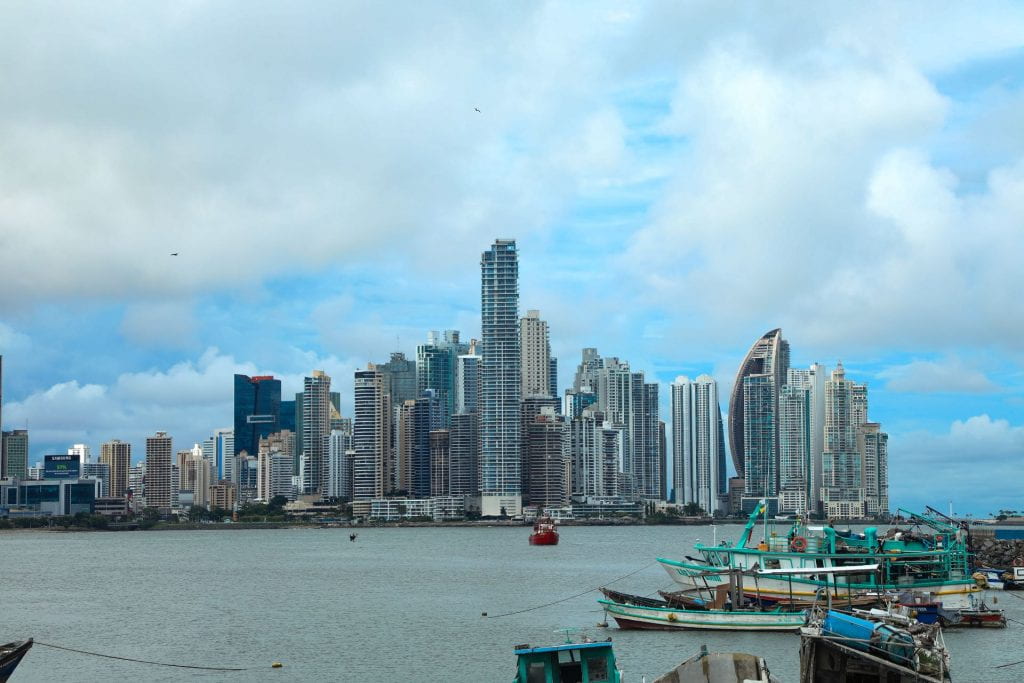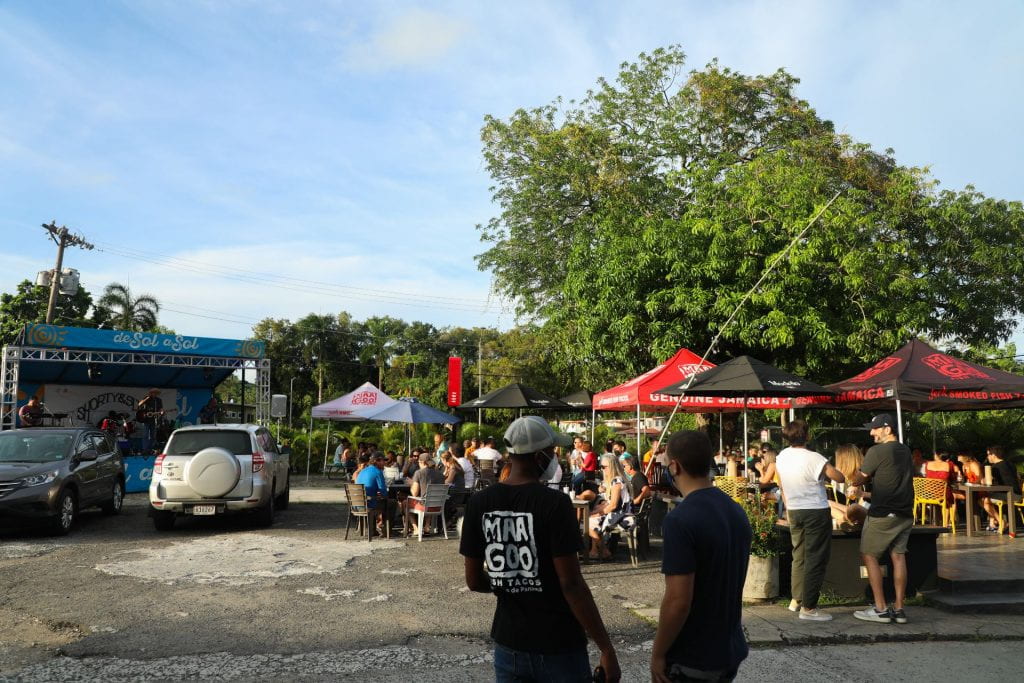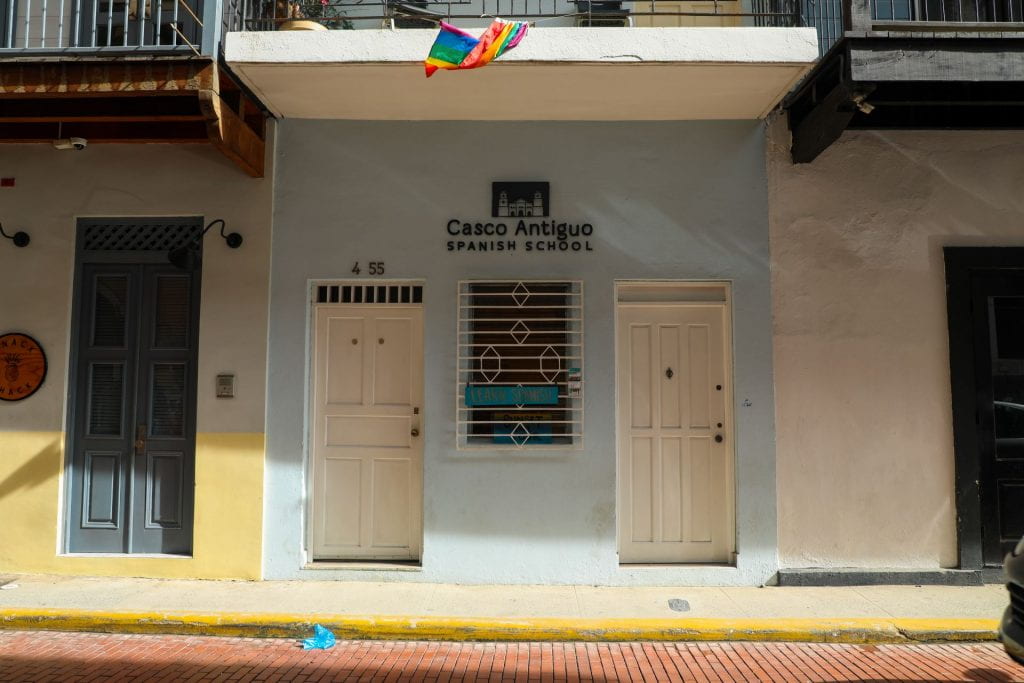Panama’s exploding expat community thrives on global influences, American past
By Matty Wasserman

PANAMA CITY, Panama – There’s nothing traditionally Panamanian about Maagoo Fish Tacos.
The indoor-outdoor restaurant is stationed in the Corozal neighborhood of Panama City, less than a mile from the Panama Canal. Most patrons are expats, relocated from America. The menu is written entirely in English and the food is served on Mexican-style flour tortillas, not the cornmeal cakes that most Panamanians call “tortillas.” The music is Zonian, a type of Jimmy Buffet-style satire rock, lightly infused with Spanish phrases and dated references.
The party takes place in the parking lot, where 20 umbrella-covered tables face a five-piece band on a small stage. A handful of patrons dance to the music, which changes styles jarringly and often.
The melting pot of cultures and styles at Maagoo is fitting for Panama’s expat community, which thrives on the intersection of American and Panamanian culture — a theme that dates back to the U.S. building of the canal over a century ago.
“This is the perfect example of American influence here,” Laura Manary said as the band repeated a four-word chorus of “find a job, camarón.” The crowd sang and clapped along.
“That means ‘find a job, shrimp,’” Manary continued. “It’s a saying that goes back to the canal days. And here you have local Panamanians and expats both singing along and they all know what it means. Where else are you going to find that?”

Ryan Manary, 34, and Laura Manary, 33, moved to Panama in August 2019 to teach. Before arriving, they’d spent four years living in the Bahamas. Ryan works as a 10th grade humanities teacher at the Metropolitan International School in Panama City and Laura teaches English online to both Spanish-speaking students and professionals attempting to pass language proficiency tests.
“There’s certain places we’ll go, and it’s like OK,… we’re really in Panama,” Laura Manary said. “But for the most part, we can go to lots of places like this, and it’s definitely accessible for us.”
The Manarys are just one example of the tens of thousands of American expats who’ve found a home in Panama, a small Central American nation of 4.2 million residents. With an estimated 30,000 expats living in Panama City alone, the isthmus has become a hotbed for both expat retirees and young professionals in search of a new setting and more affordable lifestyle. And while cheaper costs and tropical weather aren’t exclusive to Panama, the country’s foregin-friendly policies and widespread American influences make it uniquely positioned as an expat haven.
In 2022, International Living Magazine’s Global Retirement Index ranked Panama as the world’s top retirement destination for expats, specifically citing its affordability and government benefits. Panama lures expats with an affordable visa application process, first-world amenities and financial incentives. It offers private, first world health care and the same currency as the U.S. — another relic of America’s imprint that dates back to the building of the canal.
Jackie Lange, the founder of Panama Relocation Tours, a company that works with expats to help explore and aid the process of migrating to Panama, said an easy transition for American migrants is a large part of the country’s allure as an international landing spot.
“You have to start with the visas, it’s really affordable for people to move here… And the American dollar, it makes a huge difference for people to have that familiarity. Especially when people are first looking to make that jump to moving to a new country, [familiarity] is really important,” Lange said.
David Gold is the founder of the Casco Antiguo Spanish School, a private learning academy that primarily teaches Spanish to English-speaking expats. Gold, initially from Westport, Connecticut, moved to Panama in 2010 after spending three years as a volunteer in the U.S. Peace Corps in Bolivia. He believes Panama’s modern infrastructure, particularly in Panama City, helps soften the adjustment for expats accustomed to American living standards.
“It’s totally first-world. There’s clean drinking water here, it’s safe here. Sure, if you leave your phone out on the table and walk away, it might be taken, but I’m not really worried here about watching my back,” Gold said.
Most of Gold’s expat clients are newcomers to Panama, and many work for large, multinational corporations. Dozens of foreign companies, including Procter & Gamble, Nestle and Adidas, have their regional headquarters located in Panama. Josimar Ortiz, the executive director of the Colón Chamber of Commerce, said foreign business comprises a substantial part of Panama’s economy and identity, and the country’s geographical location and business-friendly regulations incentivize them to operate here.
“To be located right in the center of [the Western Hemisphere], having all this banking infrastructure, having all these ports and logistics infrastructure, that’s what makes it attractive for all the companies and people to come here… for business, for foreigners, Panama is always going to be a huge destination,” Ortiz said.
Experts agree that the influx of foreign money has helped to scaffold Panama’s expanding economy, which prior to the pandemic was one of the fastest growing in the world, with an average yearly GDP growth of 6.80% from 2011-2019.
The globalized economy and international commerce pulls many American workers, families and resources with them to the region. It’s also why the country, and specifically Panama City, feels modern to expats like the Manarys, who feel reassured by Panama’s reliability and U.S.-quality amenities, such as the healthcare system.
“Having a stable government and stable economy is important. But really, the biggest thing for us was healthcare. And the healthcare here, it’s first-world and we can trust it,” Ryan Manary said.

In addition to alleviating overarching concerns about safety and health, the America-inspired shops, restaurants and services provide an extra layer of comfort.
“It’s nice that you have options that feel familiar and can satisfy first-world cravings,” Laura Manary said. “Being able to access those comfort things makes it easier to adjust.”
Foreign influence in Panama
Panama’s first-world caliber infrastructure and successful globalization efforts make it an outlier among Central American nations. That’s in part because of the longstanding U.S. influence in the country, which dates back to Panama gaining independence from Colombia in 1903, aided by U.S. military efforts.
When America began constructing the Panama Canal in 1903, it created the Canal Zone, an unincorporated territory within Panama where the U.S. had jurisdiction and governing power. In 1977, the U.S. and Panama signed the Carter-Torrijos Treaty, which meant the Canal Zone would remain under U.S. governance until 1999, when control would be turned over to Panama.
Turmoil between the two countries boiled over in 1989, when the U.S. forcibly invaded Panama to remove dictator Manuel Noriega. The attack resulted in the loss of hundreds, if not thousands, of innocent Panamanian lives. In the invasion’s aftermath, a democratic, U.S.-friendly government was implemented, and since then the two countries have remained on strong diplomatic terms.
Also, though the Canal Zone’s boundaries were removed upon the U.S. departure in 1999, Panamanians with parents born in the Canal Zone can still obtain American citizenship. The canal and trade economy remain an enormous source of revenue for Panama, and Ortiz feels the infrastructure and policies implemented by America in and around the Canal Zone still reverberate today.
“Absolutely, the U.S. has a lot to do with [the infrastructure in Panama],” Ortiz said. “There’s a lot of American influence here, there’s no way of escaping it. When the United States was here [until 1999], there was an economic boon for everyone. Now, it’s still a big impact, with the canal especially.”
The Panamanian government further encourages expat and foreign migration through its affordable and accessible visa and benefits programs — which Lange feels is one of the driving factors that separates Panama as a top expat destination.
“I think the No. 1 reason people move here, specifically for retirees, is the amount of money needed to get a pensionado [retirement] visa or a working visa. It’s just $1000, one time. That’s all you need. Whereas in Mexico, you need $3000 a month to receive a visa. I know in Belize, it’s $2,500 a month. Here, it’s super simple and cheap,” Lange said.
Anyone over the age of 60 who can demonstrate a lifetime pension income of $1000 per month is eligible for the pensianado visa. The pension gives retirees steep discounts throughout the country, such as 50% off entertainment, 50% off midweek hotel stays, 25% off airfare and 25% off at sit-down restaurants.
“The cost of living here is already significantly cheaper than the U.S., but for retirees the pensionado creates an even bigger incentive,” Lange said.
Henry Ferguson, a managing partner at Panamanian-based law firm Ferguson & Ferguson, represents migrants seeking permanent residency in Panama and oversees their visa application process. He said the pensionado visa isn’t just unique because of its generous benefits, but because of how open it is to foreigners.
“What is very unique about the pensiadio program is that for retired persons, immigrants have all the same benefits as the Panamanian locals, in regards to discounts, services and goods,” Ferguson said.
While the pensionado visa caters to retired migrants, the Friendly Nations visa offers a simple process for many expats moving for work or economic reasons. The Friendly Nations visa was created by the Panamanian government in 2012, and it’s specifically advantageous for wealthier immigrants, and those with jobs already secured upon arrival. The fast-track visa is only obtainable for citizens of a pre-approved list of 48 countries – including the U.S.
“If you are purchasing land worth $200,000 or more, or you can prove you are coming here with a job, then you can get the Friendly Nations visa,” Ferguson said. “And it’s very affordable and easy.”
The Panamanian expat identity
From anywhere within Panama City, it’s easy to see where all the investment is going. Modern, glass-mirrored high-rises soar above the city, which has the third-highest concentration of skyscrapers in the Western Hemisphere. Today, the image of Panama is just as much a 50-story luxury condo development as it is a French colonial theater.
But while Panama City offers a contemporary look and modern amenities Americans are accustomed to, Lange said that many people arrive in Panama with misconceptions based on its appearance. And that can be costly.
“I’d say the biggest reason why [expats] fail here is because they see the pictures and magazines and think this is just cheaper America… But it doesn’t really work like that. You really have to embrace not just the beautiful country, but also the beautiful people,” Lange said.
And while engaging in the local community and culture is a top priority for some expat families, others further work to bridge the gap of home life in America and a global lifestyle. Expat families with greater financial means frequently send their children to international schools, like the International School of Panama, or the Metropolitan International School, where Ryan Manary works.
Audrey Menard is the head of school at the International School of Panama, and an expat herself. She moved to Panama in 2020 after working the previous four years at an international school in Bolivia. Menard said just one-third of the ISP student body is Panamanian, and many students have aspirations of attending U.S.-based universities or a desire to eventually relocate. But striking the right balance between an American-style education and embracing local values is critical.
“It’s really important that we’re balancing the need to provide students with a global perspective, but also something that is rooted in Panama as well,” Menard said of ISP’s educational approach. “At an international school, it’s always important to have an emphasis on understanding the history of the country and the culture of the country, to show that we respect it.”
Today, the Panamanian expat community spreads across the country. Panama City, the capital city and economic hub with 1.5 million residents, is the country’s top destination for expats – particularly those in search of a modern, globalized lifestyle. Other popular expat locations include Boquete, a quaint 25,000-resident city in the northwest region of the country, and Coronado, a beachfront city of 20,000 residents on the country’s Pacific coast.
The resources in place for Americans relocating to Panama have changed drastically even in the past decade, according to Gold. He opened the Casco Antiguo Spanish School in 2012, capitalizing on a need created by the increasing number of expats in the area, and the necessity of speaking Spanish to communicate in day-to-day life.

“There’s some English spoken in the tourism and restaurant industry, but once you get outside of that, there’s just not going to be a lot of it spoken. You are going to be charged $15 for a cab that should be $5. I mean, you just really have to learn it,” Gold said.
Gold’s school is now located in the plush, foreign-friendly neighborhood of Casco Veijo, Panama City’s most quickly gentrifying area. Just 20 years ago, the neighborhood was largely impoverished, and most of the population was classified by the local government as “squatters.”
Today, Casco Viejo reflects Panama’s modern emphasis on international prosperity, and the success and expansion of Gold’s business proves the demand created by the growing expat community.
“Panama is fairly different now than it was when I first got here [in 2010],” Gold said. “There’s a lot more that’s been built. It’s definitely growing, and I think COVID has exacerbated the number of expats here as well, because people are really looking for change.”
As Gold’s expat-centric business continues to expand, he reflects on how the country’s U.S. imprint and unique position as a global hub has influenced his own business and experiences while in Panama.
“The American influence, it set the groundwork and the environment for where businesses like mine can thrive,” Gold said. “The fact that all these big companies were based here, and it was growing so quickly, made it ripe for me to come and start a business supporting other expats… it’s only going to continue to grow.”